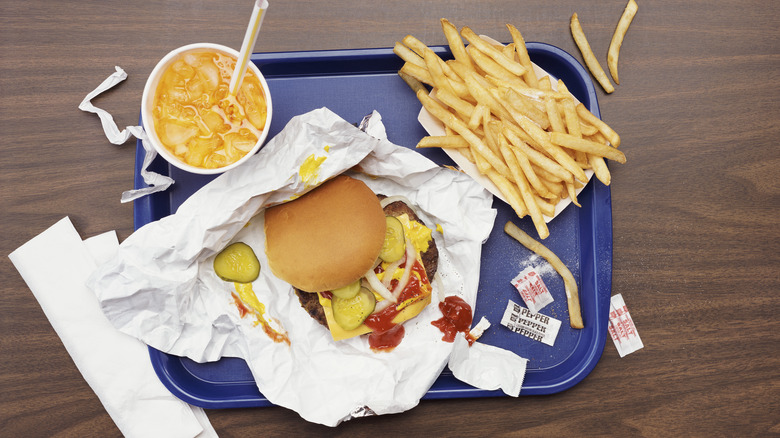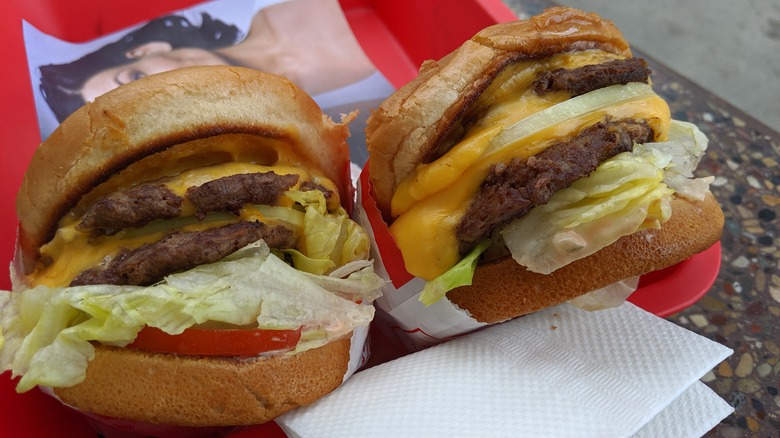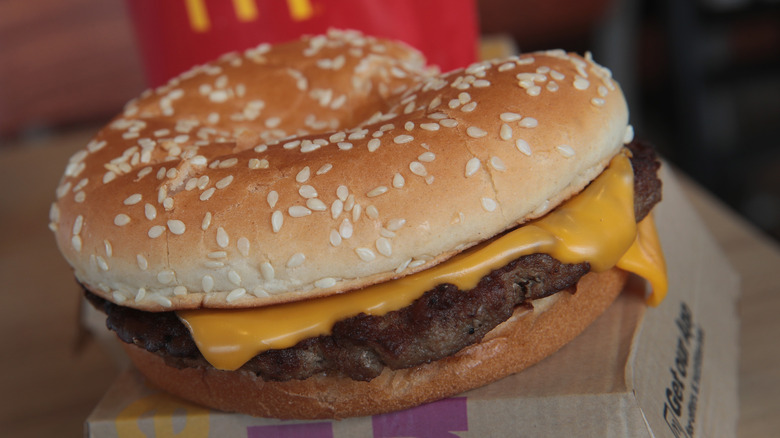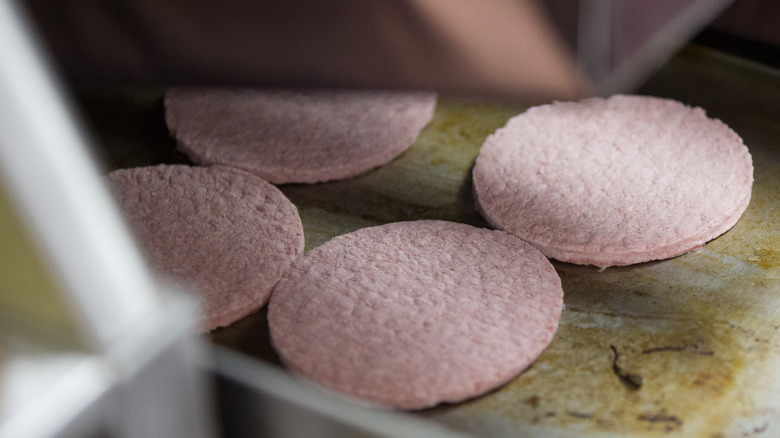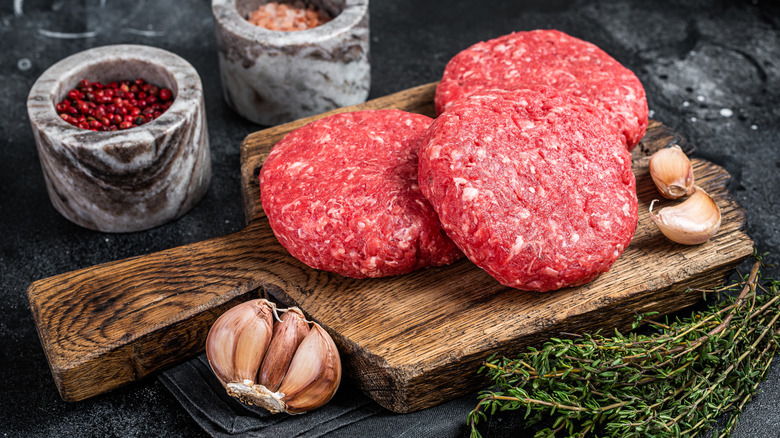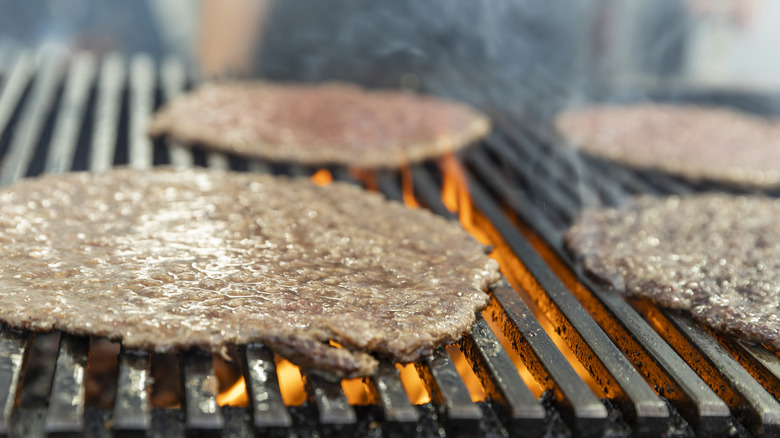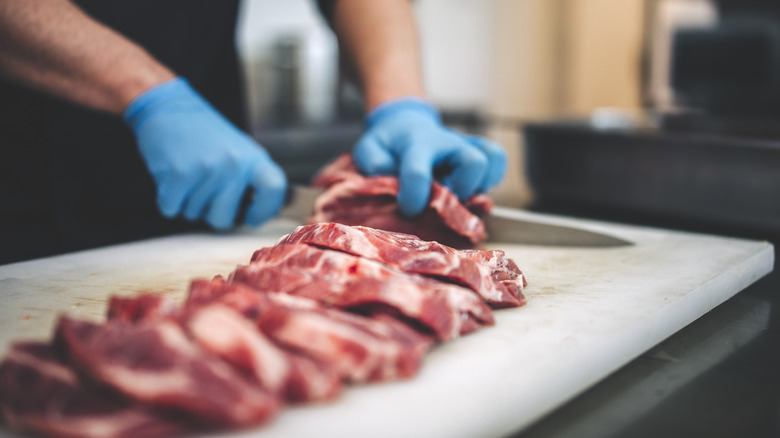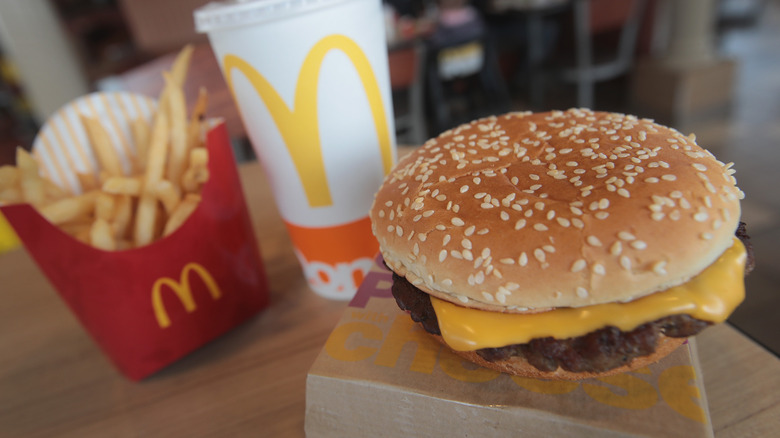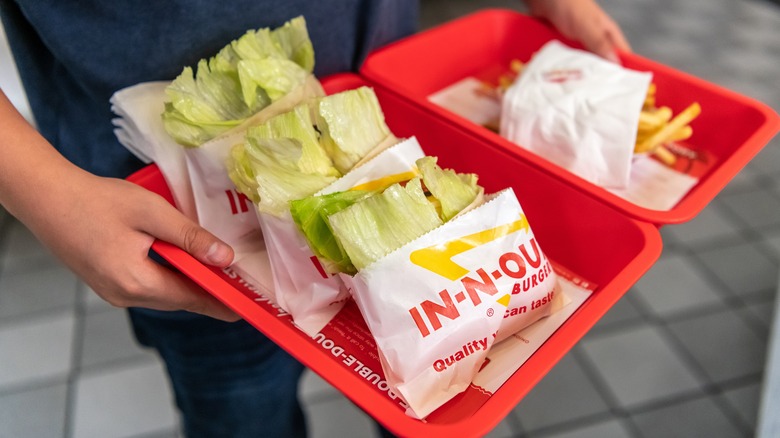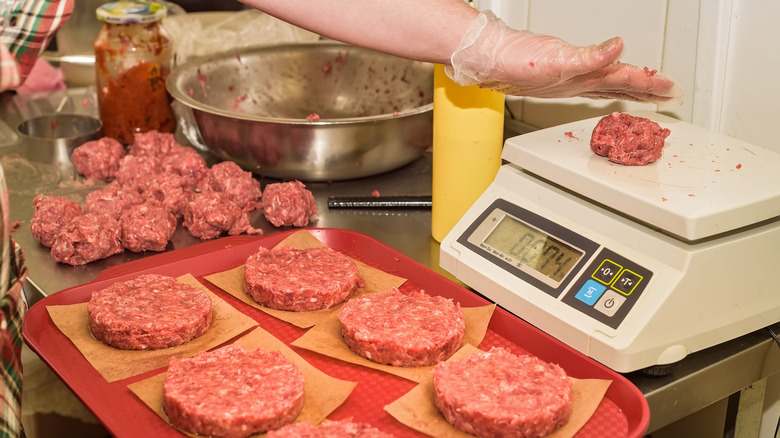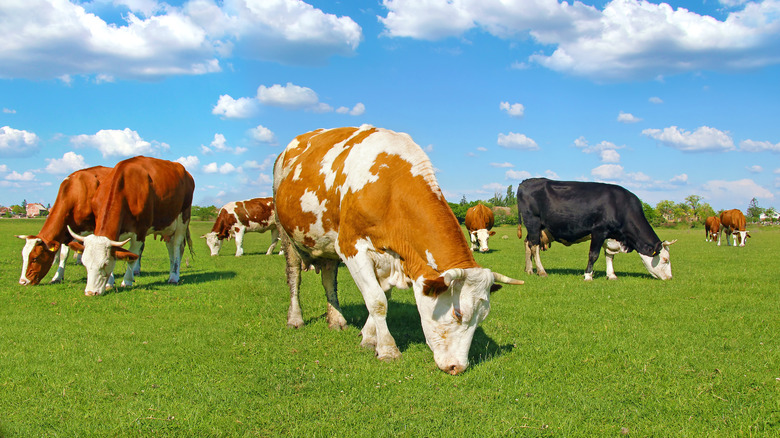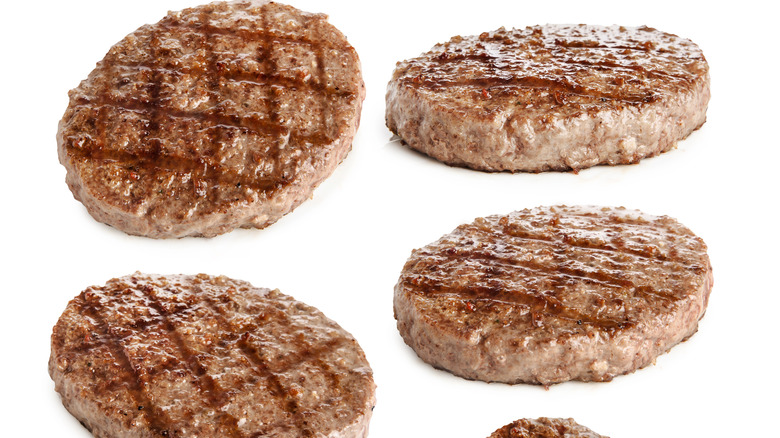In-N-Out Burger Vs McDonald's Beef: Everything You Need To Know
Both McDonald's and In-N-Out have dedicated fans who love the chains' burgers. Some people will always choose one over the other when they want to get something to eat. But what do you do when you're in a group where a few want McDonald's and others want In-N-Out? If you want to go to the place that will likely have the better burgers, how do you decide? Simply going by personal taste can be tricky as perceptions can be wildly different between people, and those who like one chain could have a very low opinion of the other.
It's better to look at how the patties are produced and what you can expect when you get them. Let's see what they have in common and what differs between them as that information could help your group settle on a restaurant. It's possible one will be the winner, and it's also possible that it'll be a toss-up. But there's only one way to find out, so here's everything you need to know about the beef at McDonald's and In-N-Out.
What type of hamburger meat does In-N-Out use?
In-N-Out uses only one type of meat for its burgers: 100% ground chuck. Chuck is a fatty cut of beef, and that fat helps the meat from crumbling apart once it's been flattened into a patty. The fat also lends the meat more flavor and keeps it moist as it cooks. That moisture conservation is very important considering how thin In-N-Out's patties can be; any moisture could easily cook away completely if the patty were made of a leaner cut of beef.
One advantage to using only one type of cut for the burgers is quality control. While ground chuck is technically ground beef, generically labeled "ground beef" is usually a mix of cuts, which can lead to varying fat and moisture content, as well as different flavor and cooking times. By using only this one cut for its burger meat, In-N-Out has an easier time creating consistent patties across its three distribution centers.
What type of hamburger meat does McDonald's use?
McDonald's burger meat uses a combination of cuts, and while the company gives some detail about the contents, it doesn't provide a complete list. The McDonald's website says only that the company uses "the trimmings of cuts like the chuck, round and sirloin." This isn't a bad mix at all; all three cuts are commonly used in burger patties. Chuck, of course, lends that fat for moisture and holding shape. Round adds more meat with less fat just to control calories, and sirloin contributes to the flavor.
However, McDonald's doesn't give the full mix, so there could be additional cuts in the patties the company uses for its burgers. The patties are guaranteed to contain only real beef. But the chance that two patties might contain slightly different mixes of beef cuts means the flavor and moisture content of the burgers could vary between restaurants.
Freshness
One of the notable differences between the two companies is that In-N-Out's burger patties are shipped and stored fresh — they're never frozen. The company makes its own patties at three locations in Baldwin Park and Lathrop, California, and Dallas, Texas, and ships them directly to its restaurants. In fact, one of the reasons why In-N-Out was so slow to expand its number of locations was because it had a rule that any location had to be within 300 miles of one of its meat-processing facilities. In 2023, however, the company announced it would expand to Tennessee and ship patties from its Texas facility to the state, well outside the 300-mile range, but the company hasn't announced any intent to start freezing the patties.
McDonald's does freeze most of its hamburger meat and claims it takes about two or three weeks for the meat to go from patty formation to actually being cooked for a customer. However, much of the beef used for Quarter Pounders has been fresh and not frozen since 2018.
In terms of nutrition and quality, frozen and fresh patties don't necessarily have that many differences, but the economic and practical differences are huge. Freezing the meat makes it easier to store for longer times, but it also means that the restaurants need additional equipment such as freezers to keep the meat cold. Using fresh patties introduces the risk that the patties will go bad before they can be used, and the patties cook much faster than their frozen versions.
Seasoning for the patty
The differences in how McDonald's and In-N-Out season the patties are pretty stark when you add In-N-Out's secret menu into the mix. McDonald's uses only a dash of salt and pepper on each patty as it cooks; after that, the only flavoring added is the ketchup and other condiments usually placed on each burger as it's being put together.
In-N-Out's burgers are a completely different scene. The basic patties have a little salt added, but you can request to cook the patties without salt — or with more salt, if that's your thing. You can also ask for the patty to be mustard-grilled, which is when a layer of mustard is placed on the top of the patty as it's cooking just before it's flipped over to cook the top side. Once the patty is cooked, the range of seasoning doesn't stop there. You can have chopped chilis pressed into the patty, or have chopped onion that's been grilled on the same grill as the patties (meaning it has all that extra burger flavor mixed in) added to your burger. Whole grilled onions, burger sauce, and other additions let you customize the taste of the final product.
Appearance
Both In-N-Out and McDonald's make their burger patties very thin, and this is one area where they don't differ all that much. In-N-Out burgers are pressed thin enough so that they cook within about four minutes. This is why using that 100% ground chuck with all that fat is so important; you'd have a rather dry burger without it.
That leads to the question of what happens to McDonald's patties because they're super-thin, too, and the chain uses a less fatty mix of meat cuts. In fact, the burgers can be so thin that sometimes customers have trouble finding them, as one woman in the U.K. claimed in 2017. She told The Sun newspaper that she put a picture of the patty "on Facebook for [her] friends to see and no one could guess what it was. Someone thought it was a beetroot wafer, another thought it was one of the Frazzle crisps."
McDonald's patties are so thin that those stories about McDonald's food never rotting for years actually make sense. Those seemingly never-rotting burgers simply dry out. There's just not enough moisture in the smaller patties for them to mold and rot. However, a larger patty, like those used in the Quarter Pounder, does have enough moisture to mold if left to sit for a long time.
Origin
Both In-N-Out and McDonald's, at least in the U.S., source their meat from third-party suppliers. Neither has its own ranches, which isn't a surprise. The main differences are in which suppliers provide the beef, and where the patties are formed. In-N-Out gets fresh beef from a number of suppliers that it doesn't name; the most well-known and oft-reported by other news organizations is the Harris Ranch Beef Company in California. This is a major beef producer whose ranches along Interstate 5 apparently inspired Michael Pollan to write The Omnivore's Dilemma. Whether that sourcing will change as In-N-Out changes its meat supply to one without antibiotics, which it announced in 2016, is unknown. Once In-N-Out has the beef, it cuts and grinds the meat and forms the patties at its own facilities.
McDonald's names two meat suppliers, Lopez Foods and Keystone Foods, on its website. Keystone Foods was the first to make Individual Quick Freezing, or IQF, patties for McDonald's back in the 1960s. When the company switched to using fresh patties for its Quarter Pounders, Lopez was the first supplier to install the necessary equipment for handling and storing the unfrozen meat. All meat processing is done at the farms, rather than by McDonald's itself.
Antibiotics, preservatives, and additives
Speaking of antibiotics, both companies have made public their policies toward using preservatives, additives, and antibiotics. The bad news is that neither company currently uses beef that is antibiotic-free despite announcing the intent to do so. In-N-Out announced a planned switch in 2016, with no news since then. McDonald's announced its intent to reduce the amount of beef it used that was not antibiotic-free in 2018, two years after it made its U.S. chicken products antibiotic-free. However, in 2022, the company was criticized for continuing to use beef from livestock treated with antibiotics. McDonald's already uses antibiotic- and hormone-free meat in the U.K., by the way.
The good news is that it's a slightly different story regarding preservatives, additives, and fillers. Again, In-N-Out is clear about its use of 100% ground chuck only for its burgers, and it claims not to use any additives, preservatives, or fillers. McDonald's guarantees that its burgers are 100% beef with no artificial preservatives, flavors, or colors. McDonald's says its pickles contain an artificial preservative and that people who want to make their burgers totally free of artificial anything should keep that in mind.
Secret menu items
In-N-Out is secret-menu royalty. While the chain has a few secret items listed on its website, the actual list of combinations is huge. The secret menu is one reason why so many people like In-N-Out and line up for hours when new locations open — you get a chance to create a burger that's customized exactly to your taste.
McDonald's has a secret menu, but this one is more of a do-it-yourself adventure that makes the rounds on social media and websites. In 2022, McDonald's made some of the secret combinations public and allowed people to order them by name. However, you'd get only the components for the items, and you'd have to assemble the creations yourself. One secret burger is the McBrunch Burger with eggs, bacon, and hash browns, which is available (according to TikTok) only at 10:35 a.m., during the transition from breakfast to lunch and dinner items. Apparently, some employees may make it for you, but others report having to order the items separately and build the burger on their own. Other options involve asking for the employees to make specific modifications, such as the Monster Mac, in which you order a Big Mac and ask the employees to add eight patties.
Patty sizes
The two chains use different patty sizes. In-N-Out uses 2-ounce patties across the board. Using one size makes patty formation more efficient as the patty-making facilities don't have to set up equipment to produce a second size, and cooking is a lot easier as the only variations you have to worry about are due to issues like doneness and adding cheese. One person who claimed to be an In-N-Out employee told Reddit that burgers were cooked according to a chart that each store had; the employee didn't know the time it took to cook each type of patty, but the chart gave cooking times for options like well-done burgers and cheeseburgers.
McDonald's has two sizes of patty. The classic burger patty is 1.6 ounces, and the Quarter Pounders are, of course, 4 ounces (or a quarter of a pound) before cooking. In 2022, some Australian customers complained that the burger patties were getting much smaller, but McDonald's denied making any changes. It's possible that the cooking process had something to do with it, because heat melts fat and evaporates moisture, effectively shrinking the patty. This is why burgers whose name focuses on the patty weight tend to have disclaimers that the measurement is based on the weight before cooking.
Grass-fed status
Neither In-N-Out nor McDonald's use grass-fed beef for burgers, although McDonald's has taken some steps toward it in Australia. In-N-Out has no policy on grass-fed beef, and a 2012 online petition was started to ask the company to make the switch. (The petition closed with only 388 signatures.)
McDonald's isn't using 100% grass-fed beef in the United States, and the only mention of it has been an April Fool's joke on a food blog. However, in March 2020 — yep, right before the pandemic — the company announced it would test a 100% grass-fed beef burger in Australia using only Australian beef. The burger was supposed to be a limited-time offering, and there's been no public announcement about continuing to serve grass-fed beef. The company's Australian website doesn't mention grass-fed beef specifically, although it does offer a couple of Angus beef burgers, and lots of Angus producers have both grain- and grass-fed options. That's not a guarantee that the Angus beef used by McDonald's in Australia is grass-fed, however.
Rumors and controversies
Both companies have had to deal with their share of rumors and controversies. In-N-Out has fared a little better in this regard because the controversy that it's had to deal with was not one of its making, and its high-quality food has saved it from the usual fast-food fear-mongering that hits so many other chains. In 2012, one of In-N-Out's beef suppliers was closed down because of its inhumane treatment of "downer" cows. These are cows that are disabled and potentially sick, and it's been illegal to use downer cows for food in the United States since 2009. In-N-Out claimed it severed ties with the supplier once it learned about the abuse.
McDonald's has been the subject of plenty of rumors, however. For example, McDonald's used to use a processed meat product called colloquially known as pink slime. This is finely ground meat treated with a chemical that kills bacteria. McDonald's stopped using pink slime in 2011, but a 2022 video claimed that the company was using cow remains picked up off the floor to produce pink slime. The Associated Press debunked the rumor. Another claim that McDonald's burgers contained human meat was from a satirical website, and yet another rumor claimed that McDonald's 100% beef was actually a product from a company called "100% Beef" and not actual beef. Snopes debunked that one. There are plenty more rumors online if you want to get some exercise by rolling your eyes.
Final thoughts
Most comparisons have a clear winner, but we can't really tell you which burger patty to choose from these two options because the known differences are important mainly on a personal preference level. Even the factors that should produce a clear winner are kind of vague. For example, McDonald's seems to be taking more steps toward reducing antibiotic use in its beef, but both McDonald's and In-N-Out are still using beef from livestock treated with antibiotics. And just because In-N-Out hasn't said much doesn't mean it isn't doing anything about it. That's the kind of thing that could elevate one chain over the other, yet the information available makes it impossible to issue a sweeping claim. You have to judge the burgers on subjective things like preferring McDonald's flavors or In-N-Out's fresh-only policy.
That being said, some rankings could help you choose if you're looking for a very specific item. For example, if you want to find the "healthiest" cheeseburger, you might want to go to In-N-Out, according to a 2023 survey. A 2022 survey found that people preferred In-N-Out for overall customer experience. Yet you'll also find opinions stating that McDonald's is more satisfying than In-N-Out and studies claiming McDonald's basic hamburger is better than In-N-Out's hamburger for weight loss. All we can tell you is to look at the differences and similarities and decide which burger patty is closer to what you prefer to eat. One thing's for sure: That's a tasty test you've got ahead of you.
